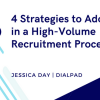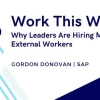With rigorous government regulations and internal policies, compliance issues pose a serious risk for companies that do not have visibility into their external workforce says Vish Baliga, CTO at SAP Fieldglass. He shares how visibility into the external workforce helps avoid maverick spend, ensures preferred suppliers are used in line with negotiated rates, and how strategic planning and partnering with workforce vendors to identify and procure the appropriate talent can conserve a lot of money, time, risk and effort.
It’s Friday afternoon and you are finishing the last of the week’s Human Resources (HR) duties before heading off to a relaxing weekend with friends. Just as you cross that last item off your list you receive a call from your Chief Human Resource Officer. You answer, hoping that any ask might wait until next week. Unfortunately, what you hear on the other end of the line is an HR nightmare and you realize that Friday night cocktail will need to wait a little longer.
The CHRO informs you that a previous external employee, whose contract was terminated a few weeks prior, did not return their security badge and laptop. Now you have a disgruntled ex-employee and security issue on your hands. That contingent worker logged back into the system and accessed sensitive data, including social security numbers, customer and employee profiles, and sold them on the black market.
This story sounds extreme. But I’ve been focused on the topic of external workforce management for quite a while now, and things like this can, and do happen. I’ve also heard many stories about unusual but challenging situations in companies, including where a past external worker continued to take advantage of the free lunches in his previous workplace because his security tag was never deactivated!
Running a business with a high level of risk is a lot more common than companies realize. In today’s volatile environment, companies need a highly skilled flexible workforce – one that can rapidly scale up or down – to build business resilience. Hence the external workforce (also known as “contingent workforce,” “freelance workforce,” “workers on Contract/SoW” or “recurring service providers” and “gig economy”) is playing an increasingly central role in the way we work today. In a study conducted by SAP in conjunction with Oxford Economics, 55% of executives state they would be unable to conduct business as usual in their company without it.
Despite this growing dependence on contingent workers and services providers in many organizations, some executives lack visibility into the fundamentals of their external workforce.
The study also recognized that many organizations lack visibility into even the basics – like contract terms, who is doing the work, where they are located and what they are doing. This has major consequences, leading companies to speculate when it comes to making decisions, because they can’t manage what they can’t see.
The result? Digital security breaches, safety risks, compliance issues and maverick spend are some of the problem areas companies face when they don’t have visibility into their contingent workforce, therefore exposing companies to risk.
Security Breaches
Temporary workers have set dates on their assignments. If their contract is terminated earlier than anticipated, it is important that they are properly offboarded following the end date and immediately return any devices, accessories and security cards. This prevents unauthorized access to buildings or confidential information once their contract has ceased. If the offboarding is not correctly completed, companies run the risk of intellectual data theft or ex-workers continuing to gain access to company systems and buildings.
Safety Risks
Incomplete onboarding is another area that can cause risk for companies. Onboarding can sometimes be overlooked due to a misunderstanding between the supplier and the hiring manager as to who carries out that process. Incorrect or non-existent onboarding can cause risk for some companies more than others. Take those who need to complete safety training in order to carry out their role while also ensuring all co-workers are safe. If such training is overlooked, it can result in a greater number of casualties on the site.
Compliance Issues
With rigorous government regulations and internal policies, compliance issues pose a serious risk for companies who do not have visibility into their external workforce. Compliance breaches from a government regulations perspective can result in hefty fines, court appearances and more, while external employees who do not adhere to, or are not aware of internal policies can run the risk of poor-quality work, not meeting milestones, or not delivering projects on time.
This affects a company’s integrity, and bottom line, with one in four projects undertaken by services providers not being completed on time or on budget. Tenure tracking and managing across different engagements is key, external workers will often show up under contingent worker for an assignment and then may show up under a service contract. Unless the individual is wholistically tracked they may end up violating company policies and possibly some regulations.
Maverick Spend
With non-compliance affecting both the company’s reputation and their bottom line, visibility into their external workforce is essential to avoid maverick spend. It also ensures preferred suppliers are being used in line with negotiated rates so companies can better manage their overall costs.
To avoid the negative effects of an angry ex-contingent worker, protect their intellectual data and avoid risk, companies need to place a stronger emphasis on how they manage their external workforce, much like the way they manage their full-time employees.
Strategic planning and partnering with workforce vendors to identify and procure the appropriate talent can conserve a lot of money, time, risk and effort. Combining an external workforce with better budget and timeline management, as well as digitizing processes, can further reduce risk by gaining resource visibility, maximizing cost savings, and improving worker quality and efficiencies.
With the external workforce set to remain a top priority for many companies, those organizations must master the art and science of contingent management. In doing so, they can select the right talent, make better business decisions and maximize their investment, all while eliminating some invisible costs of compliance, risk, and productivity. This will allow companies to realize the full value and gain every competitive advantage from this flexible resource. And it would let those HR professionals start their weekends on time!







